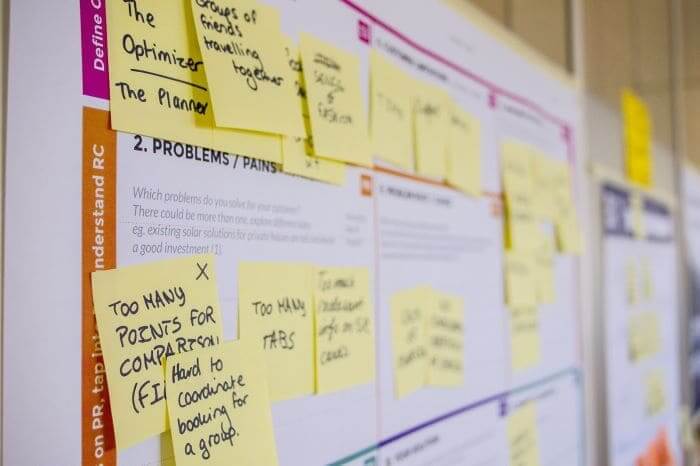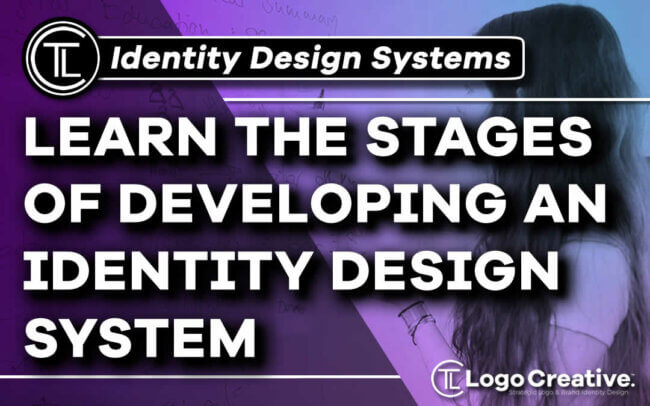In this article we discuss the Stages of Developing an Identity Design System.
Table of Contents
What is Brand Identity?
Brand identity is a philosophical concept that includes everything (what, how, and why) a business does. A brand identity system is a collection of matching elements to communicate the brand’s personality.
It includes verbal and non-verbal ways of communication. Visual branding is the face of the brand, it is the cover and the top layer. Along with verbal communication, they create the experience and style of the brand.
Similar to people’s personal styles, you can and will judge the brand based on its visual and verbal communication.
You judge, categorize and try to understand the book by its cover and title, and people by their clothes, hairstyles, and ways of speaking. The same thing happens to brands each time they reach an audience.
Why is Brand Identity Important?
Brand identity’s goal is to create an accurate impression of what the brand is. This is done in order to reach the desired target audience.
The goal is to differentiate the brand from others and convince customers to choose their products and services over others.
Brand identity can drive sales and create loyal customers when it is done well.
What are the Elements of Brand Identity?
Graphic designers and visual experts are responsible for visual while copywriters are in charge of verbal communication. The products of their work are the elements of brand identity.
All of their creative decisions are based on the brand strategy, which is the direct step before design. All means of communication must match the style and purpose of the brand.
So first of all, we must have the purpose pronounced.
The Process
The first step of the process before designing involves brand discovery, market research, brand strategy, and creating the creative brief.
The second step is the design itself. The purpose of the process is to communicate these previously set ideas visually.
The third stage takes place after design. All the designed elements come alive in practice during the marketing activity.
Before Design

Brand Discovery
What, how, and why is the golden circle taking the first steps to identify a brand? You set the personality and explain the position and purpose of your brand.
You must set the most objective part: what you offer. Name your products and services.
The next step is setting out how you offer it, meaning what things differentiate you from your competitors. How your products and services are different from theirs.
Why should customers choose your products over theirs? Position your brand on the market.
The most important and emotionally charged part is to pronounce why you do it. This is a stage that will drive love for your brand and attract followers and buyers.
Set the purpose of the brand and explain the passion, the motivation of your work, and the reason for its existence.
Write a mission statement for your brand and explain how your work leaves the world a better place than it was before. Tell how it helps people.
Your why should never be to accumulate money or to get rich. Your purpose should be much higher and more important than material benefits.
If you are willing to put the idea first and money second, the latter one will follow as the result of your work. Think of enthusiastic start-ups with a good product.
Their drive and higher goals and honest belief matched with the need for their work will create all the loyalty they can get.
Successful brands have a good reason to exist and a problem to solve.
Write your vision, an ideal final goal where you want to arrive in the distant future. Vision can be a grandiose and unrealistic idea at the time you write it.
This goal should drive your work and motivate you towards your greatest purpose.
Market Research
After you know the what, how, and why, it is time to research the market in greater detail. This involves two main focuses: one focusing on your competitors and another on your target audience.
Identify the fields where you want to be recognized. Identify your competitors in order to learn best practices from them and set out how you can be different from them.
Identify your buyer persona to find out who you are talking to in order to find the best way to reach them. Identify them by age, gender, location, income, and level of their education.
To be able to use the benefits of greater detail, dive deeper into their goals and motivations to buy your products, name their pain points and fears.
Describe their desires in life and in a product. Research possible influencers they might follow and willingly listen to.
Brand Strategy
After you have collected all the important data and pronounced the mission statement, you have to find a place for your brand on the market.
Building a brand strategy is about making the purpose of your brand actionable.
Brand strategy will map out how you benefit from the knowledge you earned in these previous steps. You will plan how the personality of your brand is going to show to your ideal customer.
And how it will convey your purpose, promises, and how you solve problems for people.
Repeat your mission statement and focus on how this time. Gain information and name how you want to act on your plans.
Write your brand story and plan the style of messaging. These are essential bases and guidelines for the design process.
Your designers and writers will create visuals and texts based on the brand story and the style.
Some leaders think that it is a good place to start right here. While it is true that this step is directly tied to the first verbal and visual elements of the brand, you should not miss the long list of steps preluding it.
In order to guide the design team in the right direction, you should have a clear understanding of what you sell, how you do it differently from others, and what the great cause of your hard work is.
Create a Creative Brief
The purpose of the creative brief is to set specific goals and needs for creative projects and make sure that everyone is on the same page.
This document will help the design team to interpret the brand personality and research knowledge in the most accurate way.
Creative briefs are usually written by the agency which is designing for you. However, you have to do your best to answer their questions properly and give them all the knowledge they can get about your brand and goals.
Share the what, why, and how. brand mission and vision. Detailed details about competitors and target audience Include your brand story, messaging style, and brand voice.
The goal of this big design project is to create a visual representation of the brand identity. But even in the future of the brand, each creative project starts with creating a brief to ensure that all creative messages are on-brand.
Design Process

Brainstorm Visuals
All visual decisions must have a solid, well-thought-out foundation. Creating the elements starts with brainstorming.
At this stage, pronounced ideas attach to more abstract ones for the first time but still as verbal associations.
Start with picking 5 words that describe the brand personality and continue by attaching further associations to them.
For example in case one of these words is ‘intelligent’, that can bring the association of a lightbulb, a spark, reading glasses, books, etc.
These associations already convey some visual meaning and can be translated into images.
Design the Individual Elements
The designed elements must express the unique identity of the brand and be explanatory of the mission and vision.
Beyond creating an accurate representation of the brand persona, the design should also be memorable, up to date, categorized yet differentiate the brand from others.
The logo is the most widely known element of the brand identity design. This graphical element is the main symbol of the business.
It is essential that it is simple and recognizable, while also matching the mission and personality of the brand. The type of displays and media should be considered throughout the design process.
Corporate design assets also include typographical elements, font families, font pairings, and hierarchy. A single primary typeface can lead to brand design and make it immediately recognizable.
Harmony is always a guideline and goal when it comes to design, and certain rules always help designers follow best practices of harmony.
In case of typographical decisions, it is recommended not to use more than two font families. These families will include several styles that make the available choices wide.
When mixing two font families, they should be contrasting. One common way to do that is to pair serif and sans serif font families. Set hierarchical and usage rules with examples for future practice.
Determine the alignment of the texts in certain cases. Modern brands usually align even the title and headings to left or right, while the central arrangement appears more in the case of traditional brands with classic values.
These rules are very sensitive though, and examples should show the specifics.
The color palette must not contain more than a maximum of three colors, though some brands have gotten away with more.
Beyond these, choose a light and dark color, which might not necessarily be black and white, but it could also be beige and dark grey or light pink and dark navy.
The feel of the visuals changes incredibly when black and white are substituted. Dark and light choices should stem from the three main brand colors and be one of their lighter and darker shades.
Brand colors also convey brand messages on purpose. They position the brand among others, give it a unique tone, and can even make it a trendsetter.
Forms and shapes tell a lot about the purposes and style of the brand. Recall the immediate feeling when you think of an edge of a square versus the round shape of a circle.
These feelings and the alterations of forms must match with the brand persona. The style of forms and shapes repeat throughout the visual brand messaging.
These decisions set the style of the icon sets and illustrations just to mention a few.
A step away from graphic design another essential element is still waiting. The style of imagery and photography. This often neglected exercise is an enormous part of positioning the brand.
Create the Brand Book
A brand book is a guidebook for convergence. Anyone who ever works on graphics and marketing material for this brand must be aware of the set rules.
The brand guide should be followed to ensure consistency in brand voice during later projects.
This is essential in order to avoid mixed messages. Customers are very sensitive, so all means of communication must show the same ideas through the design decisions.
It is a very sensitive and often failing topic for especially small brands on a low budget.
Having an onboard brand management team or regular employee training are two ways to keep your team organized.
If the brand can afford it, it is much better though to keep the designer or agency who worked on branding and hand them over anything that comes up along the way.
Design Elements in Practice
The design process continues with practice. When all rules are set, and well-designed, the process of building the actual, visible elements starts.
This process usually includes the most essentials: website design, packaging, business card design, email signature, and many more, based on the purposes and needs of the brand.
After Design

Marketing
Though several steps and decisions lead to this point, it is only the beginning. Keep consistent communication going. Use design principles in practice.
By this point, all of the branding’s purposes are called marketing, which requires campaigns with briefs that follow the brand guide. Marketing activities should introduce your brand, remind customers of your presence, and call them to action for sales.
SEO, content marketing, email marketing, social media marketing, and paid advertising are the only few ways to practice marketing. Any great marketing intern will know these basics.
After running a campaign, analytics will tell you about its success. Take the lesson thought through this data and restart the never-ending cycle of running your business, while repeating the what and how but especially the why.
Join The Logo Community
We hope you have enjoyed this article about the Stages of Developing an Identity Design System. If you would like more personal tips, advice, insights, and access to our community threads and other goodies, join me in our community.
Learn from our Founder Andrew who personally writes our community newsletter. You can also comment directly on posts and have a discussion.
*TIP – Looking for the best quality design mockups? We use and recommend Mr Mockup they are great for all your fonts, mockups and design bundles. A Lot of other top design agencies around the world use them also.


